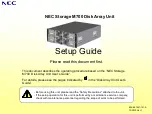
Glossary
1 rack unit (1 U)
One rack unit as defined by the Electronic Industries Alliances (EIA). A vertical
measurement equal to 1.75 inches.
AC
Alternating current.
ATM
Asynchronous transfer mode. ATM is a network technology that supports realtime
voice, video, and data. ATM is used as a backbone technology by major enterprises
and ISPs.
Carrier grade
Rackmountable systems with features including remote alarm capabilities, front−
back cooling, front accessibility of media, rear cabling, and rugged NEBS−
compliant packaging.
Cluster
Multiple server/storage configuration using software that enables failover
protection should any drive fail.
Commodity server
A server that is replaced when it fails, instead of being repaired.
Density
Number of units in a given amount of space.
Differential SCSI
A type of SCSI signaling used when devices are spread across a room. Total cable
length is approximately 80 feet (24.4 m). Differential devices cost more than
single−ended devices.
Ethernet 10/100BASE−T
The most widely used LAN access method defined by the IEEE 802.3 standard;
uses standard RJ−45 connectors and telephone wire. 100BASET is also referred to
as Fast Ethernet.
EMI
Electromagnetic interference
ESD
Electrostatic discharge
ETSI
European Telecommunications Standards Institute; a non−profit membership
organization dedicated to standardizing telecommunications throughout Europe.
FC−AL
Fibre channel arbitrated loop. A topology for Fibre Channel in which all devices
are linked together in a loop.
field replaceable units
(FRUs)
A feature that allow one unit to be exchanged with another to minimize mean time
to repair
Hot−swappable
A feature that allows an administrator to remove a drive without affecting software
integrity.
Infrastructure services
Services that an SP runs to provide revenue services to clients. Examples include:
firewalls, DNS, log processing, authentication, mail−relay, distributed SNMP, and
low−end cache server.
I/O
Input/output. Transferring data between the CPU and any peripherals.
ISP
Internet service provider.
JBOD
Just a bunch of disks; a group of hard disks that are not set up in a RAID
configuration.
LVD SCSI
Low voltage differential; a type of SCSI signaling that supports cable lengths of up
to 39.4 feet (12 m). LVD SCSI uses data low and data high lines to increase
transmissions distance. LVD is less costly than differential because transceivers are
built into the controller chips. LVD also requires less power. Sun does not support
LVD in servers or host adapters. Sun StorEdge S1 array is compatible with third−
party LVD host adapters, although Sun does not formally support it.
Sun StorEdge S1 Array
25
Just the Facts 9/27/01




































